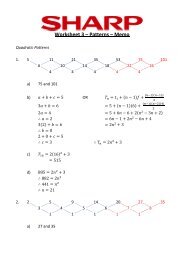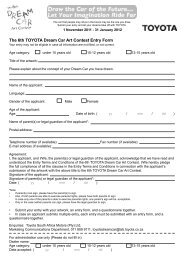curriculum and assessment policy statement (caps) - Department of ...
curriculum and assessment policy statement (caps) - Department of ...
curriculum and assessment policy statement (caps) - Department of ...
- No tags were found...
Create successful ePaper yourself
Turn your PDF publications into a flip-book with our unique Google optimized e-Paper software.
WEEK 23Suggested contact time:7 hours per weekOne teacher- directed planned class activity (ring) <strong>of</strong> ± 30 min per day (± 5 Mathematics activities per week)Content Area Content Clarification / Notes / Activities / Examples Recommended ResourcesNumbers &NumberOperationsThe meaning <strong>of</strong> thenumber 6continuedRecognise <strong>and</strong>identify the numbersymbol <strong>and</strong> the numbername• Reinforce the knowledge gained in week 22 that involves thenumber 6Count everyday objects up to 6.Count forwards <strong>and</strong> backwards up to 6.Reinforce the concepts <strong>of</strong> “many” <strong>and</strong> few”.Clap your h<strong>and</strong>s many times…STOPClap your h<strong>and</strong>s fewer times. The teacher claps her h<strong>and</strong>s up to 6 times.KinaestheticLet’s play a game:The teacher places the large cardboard number shapes or cards thatinvolve numbers 1 to 6 in order on the floor.The teacher gives the children instruction such as:‣ Sit on number 6.‣ Put your toe on number 3.‣ Run around number 2 three times.‣ Hop over number 1.The teacher can later scatter the number symbol cards.Concrete using 3-D objectsLet learners:‣ Count objects in the classroom involving numbers 1 to 6.‣ The teacher places objects in a pile on the table. Let learnersestimate how many objects are in the pile. Count themafterwards.• Recognise <strong>and</strong> identify the number symbol <strong>and</strong> the numbername that involves the number 6Count everyday objects up to 6.Count forwards <strong>and</strong> backwards up to 6.Number songs <strong>and</strong> rhymesA set <strong>of</strong> large cardboard number symbol cards.You can also paint them on pieces <strong>of</strong> thick plastic orcardboard16 34Number songs <strong>and</strong> rhymes25ApproximateDurationSuggested FormalAssessment1 day By the end <strong>of</strong> week 23,assess <strong>and</strong> recordwhether learners can:1 dayRecognise the numbersymbols <strong>and</strong> numbernames 1 to 6 on aconcrete <strong>and</strong> semiconcretelevel.Link the same number <strong>of</strong>objects to the number <strong>of</strong>pictures <strong>and</strong> dots thatinvolve number 1 to 7.Recognise <strong>and</strong> identify thenumber symbol <strong>and</strong> thenumber name that involvenumbers 1 to 7Identify house number <strong>and</strong>own telephone number.Orally solve addition <strong>and</strong>subtraction problemsusing story sums <strong>and</strong>counters with answers upto 7.Copy from a givenconstruction.Identify the colour brown.Reinforce the concepts <strong>of</strong> “many” <strong>and</strong>”few”.Clap your h<strong>and</strong>s many times…STOPClap your h<strong>and</strong>s fewer times. The teacher claps her h<strong>and</strong>s up to 6 times.\Show an awareness <strong>of</strong>symmetry in him/her self<strong>and</strong> the environment.56 | P age
















